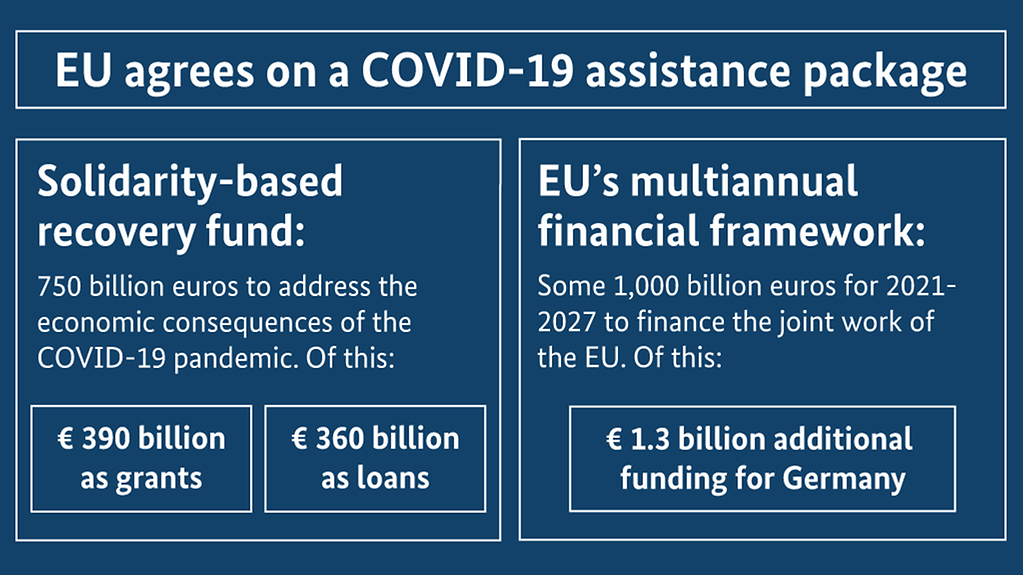FAQs
The EU institutions have reached political agreement on the Multiannual Financial Framework (MFF) 2021‑2027 and the Next Generation EU (NGEU) recovery plan. For the first time, with the conditionality mechanism, disbursement of EU funds will be tied to respect for rule of law standards.
3 min reading time

The recovery fund is earmarked above all for the imperatives of the future, climate action and digitalisation.
The diagram is entitled “EU agrees on a COVID-19 assistance package”
Under the heading are two boxes.
The left-hand box is entitled “Solidarity-based recovery fund”
The text below reads: 750 billion euros to address the economic consequences of the COVID-19 pandemic. Of this, 390 billion euros as grants and 360 billion euros as loans.
The right-hand box is entitled “EU’s Multiannual financial framework”
The text below reads: Some 1,000 billion euros for 2021-2027 to finance the joint work of the EU. Of this, 1.3 billion euros additional funding for Germany.
Photo: Bundesregierung
The agreement on the overall package is an important signal of the EU’s ability to act, its solidarity and its cohesion. The German Presidency of the Council of the EU worked intensively towards a solution over the past weeks and months. What does this mean? Here are some brief answers to frequently asked questions.
What did the European Council on 10-11 December decide?
The European Council of December 2020 cleared the way for the final steps towards the adoption of the MFF and Recovery Fund, so that the funds urgently needed for the EU’s economic and social recovery can be paid out as quickly as possible. It was crucial that the Regulation on the conditionality mechanism remained part of the overall package and can now also be adopted.
This creates, for the first time, a link between the disbursement of EU funds and adherence to rule of law standards in the respective member state. In essence, the agreement reached in the European Council clarifies and lays out precise details regarding the application of this new instrument; there is no change to the substance of the mechanism agreed with the European Parliament.
What do the upcoming MFF and the Next Generation EU recovery package look like?
The volume of the negotiated package is unprecedented in the history of the EU, at 1.8 trillion euro, with 1.074 trillion for the MFF and 750 billion for the Next Generation EU recovery fund. The MFF underpins the EU’s policy priorities for the next seven years with concrete spending programmes. Next Generation EU is intended to help the member states overcome the economic and social consequences of the pandemic. Both instruments set clear priorities in the areas of climate change mitigation and digitisation.
What happens next?
Now that political agreement has been reached on all elements of the overall package – including the Multiannual Financial Framework, Next Generation EU, the Own Resources Decision, the new conditionality mechanism and the EU’s annual budget for 2021 – all political conditions for its formal adoption are in place. The German Council Presidency aims to adopt the most important elements of the overall package before the end of the year.
Adoption requires several legislative acts. The MFF Regulation has to be expressly approved once again by the European Parliament and then, unanimously, by the member states represented in the Council. The Own Resources Decision, which is, among other things, the legal basis for the financing of Next Generation EU, must in addition be ratified in all member states. It is unlikely that this process will be completed before 2021. In most member states, ratification involves the national parliaments. In Germany, the Bundestag and Bundesrat have to approve the Own Resources Decision.
Why does the EU need a Multiannual Financial Framework?
The Multiannual Financial Framework is designed to help ensure that the EU’s expenditure is predictable. It is also intended to help maintain budgetary discipline. Moreover, the seven-year period is time enough to see whether the joint measures are effective.
A long-term perspective is also important for potential recipients of EU funding, or for authorities involved in project financing. The EU member states’ budgetary authorities, too, depend on long-term planning.
What priorities does the new MFF set?
The new MFF provides a good foundation for jointly addressing the imperatives of the future. It promotes growth, innovation and social cohesion. It also takes into account the well-established fields of cohesion and agricultural policy.
The priorities laid out in the MFF include research and stronger European cooperation in the field of migration policy. Security and defence policy, too, are covered.
Climate change mitigation plays a major part in the MFF and Recovery Plan. The quota for climate-related expenditure in the EU budget is to be increased from its current level of 20% to 30%. The MFF and Recovery Plan are also to be consistent with the Paris Agreement, and specifically with the EU’s goal of achieving climate neutrality by 2050. They are also to help achieve the EU’s new climate target for 2030, which aims to reduce emissions by 55%.